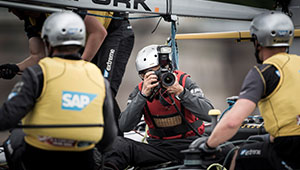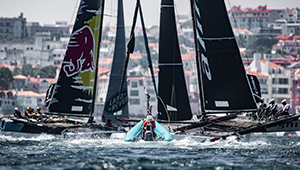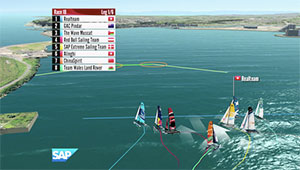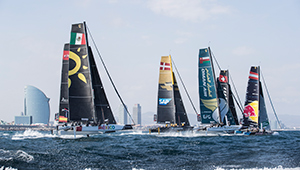A guide to foiling

What?
A hydro-foil is a lifting surface that operates in water and the GC32 is fitted with four of them. The foils are attached to each of the two hulls, the J-foil in the centre and the T-foil on the stern.
Why?
The drag caused by the boat’s hulls moving through water is far greater than the drag caused by the hulls moving through air, therefore, due to the decreased drag, a boat in foiling mode can reach higher speeds than a boat in displacement mode.
The GC32 can reach top speeds of around 39 knots (45mph) in foiling mode.
J-foil
The primary purpose of the J-foil is to create lift. This lift elevates the hulls out of the water as well as counteracting the side force generated by the sails. The ‘J’ shape of the foil makes it a self-levelling foil, which prevents the boat from stalling (dropping back down to displacement mode) once it starts foiling.
What does ‘displacement mode’ mean? When the boat’s hulls are in the water this is known as displacement mode – so called because the hulls are displacing the water.
What does ‘self-levelling’ mean? As the J-foil creates lift the tip of the ‘J’ progressively lifts out of the water and reduces the lift being produced. The J-foil naturally finds the optimum elevation, with the right amount of foil out of the water. Without this feature the foil would continue to produce lift until the bottom of the foil reached the surface of the water, at which point the boat would ‘stall’ and drop back down onto the hulls.
Operated by the sailors using a pulley system, the J-foils have two planes of movement – forwards/backwards and up/down.
Only the leeward J-foil is used to lift the boat out of the water while the windward foil is retracted.
T-foil
The primary purpose of the T-foil, which is fitted to the rudder, is to balance the lift produced by the J-foil and stop the boat from tipping over. The rudders are longer than those on a displacement boat so that the helm can still steer even when the boat is foiling over a metre in the air. Both rudders are connected, which means that they move in unison no matter which side of the boat the helm steers from.
How?
The same principles that enable an aeroplane to get airborne using its wings allow the GC32 to ‘fly’ above the water on its foils.
The shape of the foil means that water travels faster over the top surface than the bottom. Physics dictates that the faster velocity over the top of the foil also means lower pressure. With higher pressure on the bottom surface of the foil an upward force is produced, which in turn lifts the boat’s hulls out of the water.
The J-foil is like the wing of an aeroplane, producing almost all of the lift, while the T-foil is like the tailplane of an aeroplane, balancing the lift from the wing.
For the GC32 to foil it typically requires over eight knots of true wind speed and over 12 knots of boat speed downwind.




